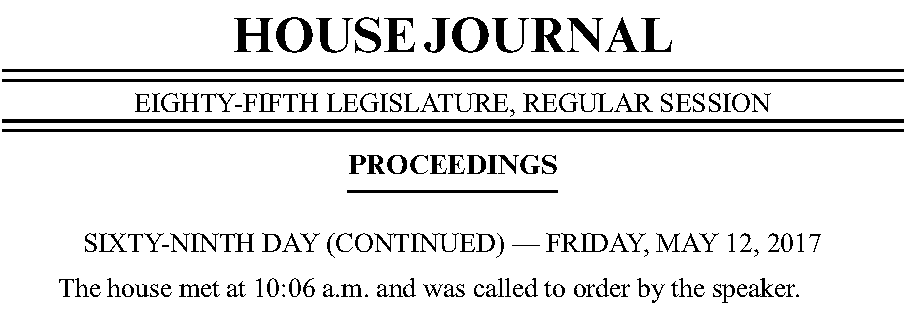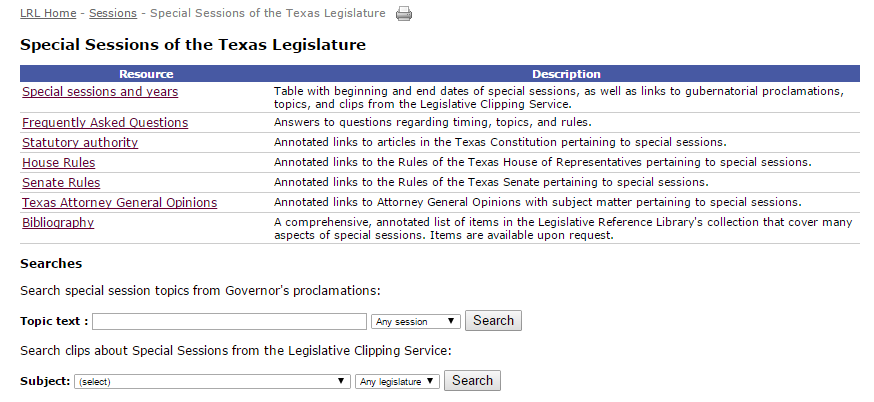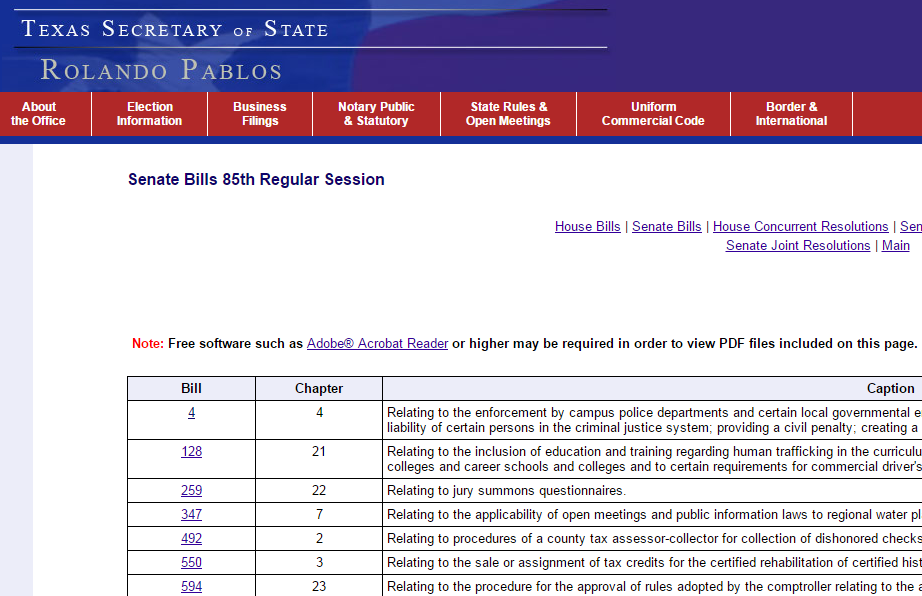Seeking historical perspective on special sessions? The LRL website's section devoted to special sessions includes past special session dates, topics, links to statutory authority pertaining to special sessions, FAQ, and other resources.
Looking for signed copies of bills, or trying to determine in what session law chapter a bill can be found? Here are some tips.
Signed copies of bills
Bills that the Governor signed or allowed to become law without his signature are sent to the Secretary of State's office, where they will be made available online on the Bills and Resolutions page. The signing deadline for the 85th Legislature is Sunday, June 18.
You can determine whether a bill sent to the Governor was signed or filed without signature by checking the bill in the Texas Legislature Online. If the bill passed but was filed without signature, you will see the action "Filed without the Governor's signature."
Signed copies from the 78th - 84th Legislatures are available online at the University of North Texas Laws and Resolutions Archive. Copies of signed bills older than the 78th Regular Session are available through the Texas State Archives. Please call (512) 463-5480.
Session law chapter numbers
The Secretary of State's Bills and Resolutions page also lists the session law chapter number that is assigned to each bill that has become law. The session laws contain the text of all bills passed into law during a particular legislative session. Chapter numbers are used primarily for citing a bill in a legislative history annotation.
For questions about bill/chapter numbers for bills from the 85th R.S., please contact the Secretary of State's office at (512) 463-5561.
Session law chapter citations for previous sessions are available online through the Legislative Archive System. To view the complete bill/session law chapter cross reference table for a session, select the legislature in the "search by session law chapter" option and leave the chapter box blank. The LRL will be working to add these records for the 85th regular session.
Week in Review, June 1
Jun 1
In this weekly post, we feature online articles and policy reports published recently, and other helpful research tools.
- Review the latest data and statistics on education in the United States. (National Center for Education Statistics, May 2017)
- Learn about sunscreens and their role in preventing sunburns. (Environmental Working Group, 2017)
- Consider the significance of diet and exercise in weight loss. (TIME, May 25, 2017)
- Read about Wisconsin Governor Scott Walker's proposal to require drug testing of childless adult Medicaid recipients. (The Associated Press, May 25, 2017)
These statistics were pulled on May 31 at 11:30 a.m. The numbers will continue to change as the governor takes action on these bills and resolutions. We will post occasional updates in the coming weeks. See our bill statistics page to compare these numbers with historical statistics.
|
House and Senate Bills
|
|
| Filed | 6,631 |
| Sent to the Governor | 1,208 |
| Signed by the Governor | 286 |
| Vetoed by the Governor | 0 |
| Filed without the Governor's signature | 28 |
| House and Senate Joint Resolutions | |
| Filed | 169 |
| Filed with the Secretary of State | 9 |
| House and Senate Concurrent Resolutions | |
| Filed | 202 |
| Filed with the Secretary of State | 13 |
| Sent to the Governor | 84 |
| Signed by the Governor | 42 |
| Vetoed by the Governor | 0 |
|
House and Senate Bills
|
|
| Filed | 6,631 |
| Sent to the Governor | 824 |
| Signed by the Governor | 190 |
| Vetoed by the Governor | 0 |
| Filed without the Governor's signature | 16 |
| House and Senate Joint Resolutions | |
| Filed | 169 |
| Filed with the Secretary of State | 7 |
| House and Senate Concurrent Resolutions | |
| Filed | 202 |
| Filed with the Secretary of State | 11 |
| Sent to the Governor | 50 |
| Signed by the Governor | 37 |
| Vetoed by the Governor | 0 |
*Statistics as of May 30 at 8:30 a.m. See our bill statistics page to compare these numbers with historical statistics.
What happens now?
The 85th Regular Session ended May 29, 2017. Bills that passed both the House and the Senate were sent to the Governor for him to sign, veto, or allow to become law without his signature. Joint Resolutions that passed both chambers of the Legislature were filed with the Secretary of State, and those that propose amendments to the Texas Constitution will be on the ballot for the November 7, 2017 election.
If the Legislature passes a bill, does it become a law right away?
No. Under Article 4, Section 14 of the Texas Constitution, bills passed by the Legislature must be submitted to the Governor for approval. The Governor can sign a bill, veto it, line-item veto an appropriation, or allow a bill to become law without his signature.
How much time does the Governor have to act on a bill?
If a bill is sent to the Governor during the legislative session, the Governor has 10 days (not counting Sundays) to sign the bill or return the bill to the Legislature with objection. If after 10 days the bill is not returned to the Legislature by the Governor with objections or he has not yet signed it, the bill becomes law as if the Governor had signed it.
If the Legislature has adjourned sine die, or if the bill is presented to the Governor less than 10 days (not counting Sundays) prior to final adjournment, the Governor has 20 days (counting Sundays) after the final day of the session to sign or veto the bill. If neither action is taken, the bill becomes law without the Governor's signature (Texas Const. art. IV, § 14).
Sunday, June 18, is the 20th day following final adjournment of the 85th Regular Session. It is the last day the Governor can sign or veto bills passed during the 85th Regular Session. The LRL's vetoes database will be updated for the 85th Regular Session as we receive those documents.
What happens to bills that did not pass?
Bills that did not make it completely through the legislative process die with the end of the session and are not automatically reintroduced during the next session.
Where can I find more information about special sessions?
You can start with the LRL's FAQ about special sessions. The LRL website's section devoted to special sessions also includes historical information, links to statutory authority pertaining to special sessions, and more.
The 85th Regular Session ends Monday, May 29. As the end of session nears, many House and Senate members have been appointed to conference committees to resolve differences between their versions of bills. For information on the conference committee process, please see The Legislative Process in Texas and Texas Legislative Information and Resources.
To see a list of bills for which a conference committee was requested, please click here. Upon receiving completed conference committee reports, the LRL scans and posts them in our conference committee reports database. These reports, as well as a list of the members of a bill's conference committee, also are listed in the Texas Legislature Online record for each bill.
The below chart provides a snapshot of bill statistics as of 11:30 am today.

Week in Review, May 25
May 25
In this weekly post, we feature online articles and policy reports published recently, and other helpful research tools.
- Explore phase one of the Capitol complex master plan. (Texas Facilities Commission, ©2017)
- Review recommended strategies for addressing Zika outbreaks. (U.S. Government Accountability Office, May 23, 2017)
- Consider commentary on various aspects of President Trump's proposed budget. (The Heritage Foundation, May 23, 2017)
- Browse FY2018 federal budget documents. (U.S. Government Publishing Office, May 23, 2017)
- Examine the spending and revenue effects of the American Health Care Act of 2017. (Congressional Budget Office, May 24, 2017)
Bill Statistics, 133rd Day
May 23
Bill statistics comparing the 133rd day of the 85th and the 84th Regular Sessions are below. For information about what happens to a bill after it passes, please see our Legislative FAQ page. To learn more about the legislative process and see bill statistics for earlier points in the 85th Regular Session, check out some of our recent blog posts.

Week in Review, May 18
May 18
In this weekly post, we feature online articles and policy reports published recently, and other helpful research tools.
- Explore the bond election results database. (Texas Comptroller of Public Accounts, accessed May 18, 2017)
- Read about the most recent data on household debt and credit. (Federal Reserve Bank of New York, May 2017)
- Search federal courts case information. (Federal Judicial Center, accessed May 18, 2017)
- Examine proposed federal legislation about a state-sponsored visa program. (Cato Institute, May 11, 2017)
You may have heard the terms "legislative day" and "calendar day" used fairly regularly over the past few months and wondered: what exactly is the difference between the two and how do they relate to the legislative process?

A calendar day is a day of the year on which the legislature may be in session, regardless of whether either the house or senate actually meet, while a legislative day is the period between the convening of the legislature and the next adjournment. To fully understand what this means and how a legislative day interacts with a calendar day, you need to be familiar with the terms "recess" and "adjournment".
Recess is a break of a meeting that temporarily pauses the legislative day. Conversely, adjournment is the termination of a meeting that officially ends that legislative day. For example, the house or senate may start a daily legislative session in the morning, recess for other legislative business, and adjourn that same evening, completing a legislative day on the same calendar day. If an adjournment occurs after midnight, the legislative day will span two calendar days. Alternatively, they may recess at the end of a day rather than adjourn, thus causing the legislative day to continue at the next meeting, whether that be later that same calendar day, the following calendar day, or several calendar days later.

There are many rules associated with specific calendar days and legislative days; the adopted rules for the house and senate specify which type of day is applicable. For example, both chambers limit the introduction of bills after the first 60 calendar days of the regular session.
A significant requirement related to legislative days is found in the Texas Constitution which requires a bill to be read on three separate legislative days in each chamber before it can become law. More than one legislative day can be completed on a single calendar day if the members agree to adjourn the meeting midday and start a new legislative day before the close of the calendar day. This is generally done with non-controversial bills such as those on the local and consent or local and uncontested calendars. This maneuver allows bills to move through the legislative process much faster, while still complying with constitutional requirements and the rules of the house and senate. Both the calendar day and the legislative day are noted in each day's journal.
As the 85th Regular Session comes to a close, keep these legislative terms in mind as you follow the house and senate as they carry out the business of Texas.



